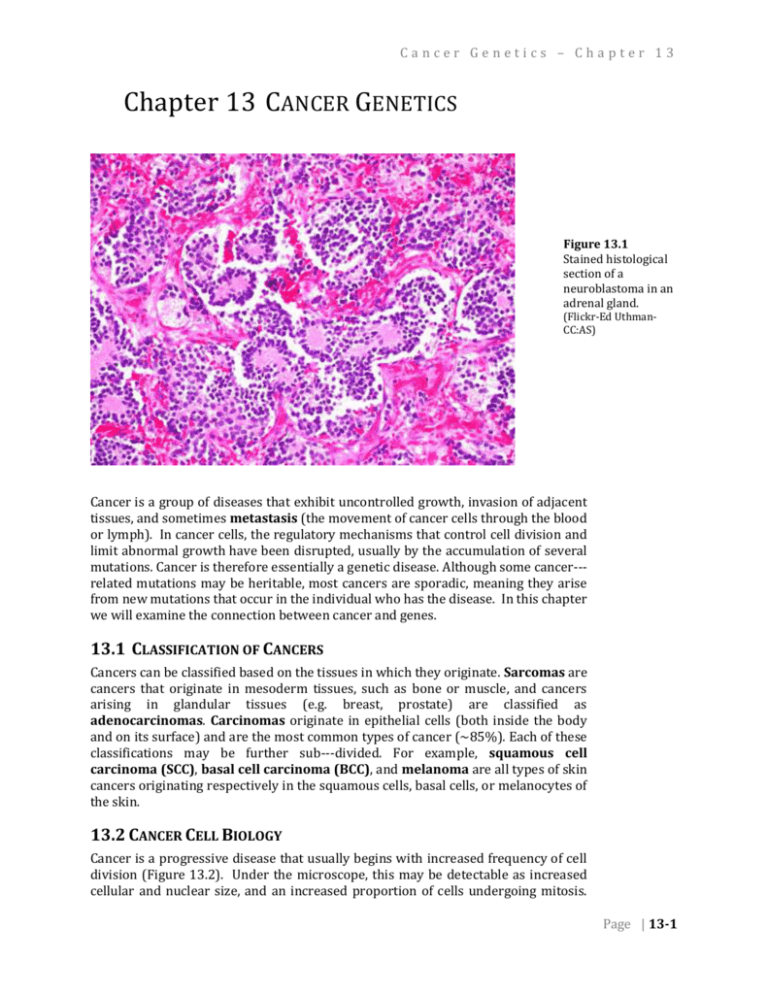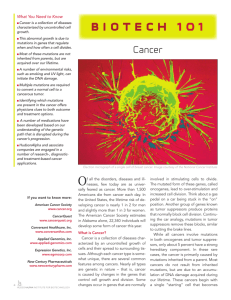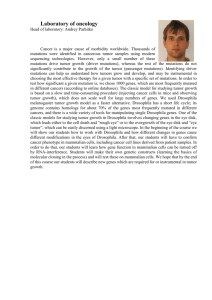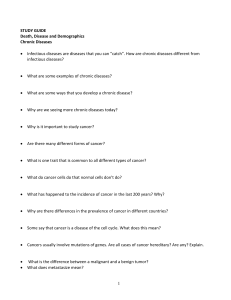zChap13_140901 - Online Open Genetics
advertisement

Cancer Genetics – Chapter 13 Chapter 13 CANCER GENETICS Figure 13.1 Stained histological section of a neuroblastoma in an adrenal gland. (Flickr-Ed UthmanCC:AS) . Cancer is a group of diseases that exhibit uncontrolled growth, invasion of adjacent tissues, and sometimes metastasis (the movement of cancer cells through the blood or lymph). In cancer cells, the regulatory mechanisms that control cell division and limit abnormal growth have been disrupted, usually by the accumulation of several mutations. Cancer is therefore essentially a genetic disease. Although some cancer-­­ related mutations may be heritable, most cancers are sporadic, meaning they arise from new mutations that occur in the individual who has the disease. In this chapter we will examine the connection between cancer and genes. 13.1 CLASSIFICATION OF CANCERS Cancers can be classified based on the tissues in which they originate. Sarcomas are cancers that originate in mesoderm tissues, such as bone or muscle, and cancers arising in glandular tissues (e.g. breast, prostate) are classified as adenocarcinomas. Carcinomas originate in epithelial cells (both inside the body and on its surface) and are the most common types of cancer (~85%). Each of these classifications may be further sub-­­divided. For example, squamous cell carcinoma (SCC), basal cell carcinoma (BCC), and melanoma are all types of skin cancers originating respectively in the squamous cells, basal cells, or melanocytes of the skin. 13.2 CANCER CELL BIOLOGY Cancer is a progressive disease that usually begins with increased frequency of cell division (Figure 13.2). Under the microscope, this may be detectable as increased cellular and nuclear size, and an increased proportion of cells undergoing mitosis. Page | 13-1 Chapter 13 – Cancer Genetics As the disease progresses, cells typically lose their normal shape and tissue organization. Tissues with increased cell division and abnormal tissue organization exhibit dysplasia. Eventually a tumor develops, which can grow rapidly and expand into adjacent tissues. As cellular damage accumulates and additional control mechanisms are lost, some cells may break free of the primary tumor, pass into the blood or lymph system, and be transported to another organ, where they develop into new tumors (Figure 13.3). The early detection of tumors is important so that they can be treated or removed before the onset of metastasis, but note that not all tumors will lead to cancer. Tumors that do not metastasize are classified as benign, and are not usually considered life threatening. In contrast, malignant tumors become invasive, and ultimately result in cancer. Figure 13.2 Progressive increases in cell division and abnormal cell morphology associated with cancer. (Wikipedia-NIH-PD) Figure 13.3 Secondary tumors (white) develop in the liver from cells of a metastatic pancreatic cancer. (Wikipedia-J. HaymanPD) . Page | 13-2 Cancer Genetics – Chapter 13 13.3 HALLMARKS OF CANCER Researchers have identified six molecular and cellular traits that characterize most cancers. These six hallmarks of cancer are summarized in Table 13.1. In this chapter, we will focus on the first two hallmarks, namely growth signal autonomy and insensitivity to anti-­­growth signals. Table 13.1 Ten Hallmarks of Cancer (Hanahan and Weinberg, 2000; Hanahan 2011) 1. Growth signal autonomy Cancer cells can divide without the external signals normally required to stimulate division. 2. Insensitivity to growth inhibitory signals Cancer cells are unaffected by external signals that inhibit division of normal cells. 3. Evasion of apoptosis When excessive DNA damage and other abnormalities are detected, apoptosis (a type of programmed cell death) is induced in normal cells, but not in cancer cells. 4. Reproductive potential not limited by telomeres Each division of a normal cell reduces the length of its telomeres. Normal cells arrest further division once telomeres reach a certain length. Cancer cells avoid this arrest and/or maintain the length of their telomeres. 5. Sustained angiogenesis Most cancers require the growth of new blood vessels into the tumor. Normal angiogenesis is regulated by both inhibitory and stimulatory signals not required in cancer cells. 6. Tissue invasion and metastasis Normal cells generally do not migrate (except in embryo development). Cancer cells invade other tissues including vital organs. 7. Deregulated metabolic pathways Cancer cells use an abnormal metabolism to satisfy a high demand for energy and nutrients. 8. Evasion of the immune system Cancer cells are able to evade the immune system. 9. Chromosomal instability Severe chromosomal abnormalities are found in most cancers. 10. Inflammation Local chronic inflammation is associated with many types of cancer. 13.4 MUTAGENS AND CARCINOGENS A carcinogen is any agent that directly increases the incidence of cancer. Most, but not all carcinogens are mutagens. Carcinogens that do not directly damage DNA include substances that accelerate cell division, thereby leaving less opportunity for cell to repair induced mutations, or errors in replication. Carcinogens that act as mutagens may be biological, physical, or chemical in nature, although the term is most often used in relation to chemical substances. Page | 13-3 Chapter 13 – Cancer Genetics Figure 13.4 Electron micrograph of HPV. (Wikipedia-UnknownPD) . Human Papilloma Virus (HPV, Figure 13.4) is an example of a biological carcinogen. Almost all cervical cancers begin with infection by HPV, which contains genes that disrupt the normal pattern of cell division within the host cell. Any gene that leads to an uncontrolled increase in cell division is called an oncogene. The HPV E6 and E7 genes are considered oncogenes because they inhibit the host cell’s natural tumor suppressing proteins (include p53, described below). The product of the E5 gene mimics the host’s own signals for cell division, and these and other viral gene products may contribute to dysplasia, which is detected during a Pap smear (Figure 13.5). Detection of abnormal cell morphology in a Pap smear is not necessarily evidence of cancer. It must be emphasized again that cells have many regulatory mechanisms to limit division and growth, and for cancer to occur, each of these mechanisms must be disrupted. This is one reason why only a minority of individuals with HPV infections ultimately develop cancer. Although most HPVrelated cancers are cervical, HPV infection can also lead to cancer in other tissues, in both women and men. Radiation is a well-known physical carcinogen, because of its potential to induce DNA damage within the body. The most damaging type of radiation is ionizing, meaning waves or particles with sufficient energy to strip electrons from the molecules they encounter, including DNA or molecules that can subsequently react with DNA. Ionizing radiation, which includes x-rays, gamma rays, and some wavelengths of ultraviolet rays, is distinct from the non-ionizing radiation of microwave ovens, cell phones, and radios. As with other carcinogens, mutation of multiple, independent genes that normally regulate cell division is required before cancer develops. Chemical carcinogens (Table 13.2) can be either natural or synthetic compounds that, based on animal feeding trials or epidemiological (i.e. human population) Figure 13.5 studies, increase the incidence of cancer. The definition of a chemical as a Dysplastic (left) and carcinogen is problematic for several reasons. Some chemicals become carcinogenic normal (right) cells from only after they are metabolized into another compound in the body; not all species a Pap smear. or individuals may metabolize chemicals in the same way. Also, the carcinogenic (Flickr-Ed Uthman-CC:AS) properties of a compound are usually dependent on its dose. It can be difficult to . define a relevant dose for both lab animals and humans. Nevertheless, when a correlation between cancer incidence and chemical exposure is observed, it is usually possible to find ways to reduce exposure to that chemical. Page | 13-4 Cancer Genetics – Chapter 13 Table 13.2 Some classes of chemical carcinogens (Pecorino 2008) 1. PAHs (polycyclic aromatic hydrocarbons) e.g. benzo[a]pyrene and several other components of the smoke of cigarettes, wood, and fossil fuels 2. Aromatic amines e.g. formed in food when meat (including fish, poultry) are cooked at high temperature 3. Nitrosamines and nitrosamides e.g. found in tobacco and in some smoked meat and fish 4. Azo dyes e.g. various dyes and pigments used in textiles, leather, paints. 5. Carbamates e.g. ethyl carbamate (urethane) found in some distilled beverages and fermented foods 6. Halogenated compounds e.g. pentachlorophenol used in some wood preservatives and pesticides. 7. Inorganic compounds e.g. asbestos; may induce chronic inflammation and reactive oxygen species 8. Miscellaneous compounds e.g. alkylating agents, phenolics 13.5 ONCOGENES The control of cell division involves many different genes. Some of these genes act as signaling molecules to activate normal progression through the cell cycle. One of the pre-requisites for cancer occurs when one or more of these activators of cell division become mutated. The mutation may involve a change in the coding sequence of the protein, so that it is more active than normal, or a change in the regulation of its expression, so that it is produced at higher levels than normal, or persists in the cell longer than normal. Genes that are a part of the normal regulation of Figure 13.6 cell division, but which after mutation contribute to cancer, are called proto- Structure of the ras protein. (Wikipedia-Mark”AbsturZ”-PD) oncogenes. Once a proto-oncogene has been abnormally activated by mutation, it is called an oncogene. More than 100 genes have been defined as proto-oncogenes. These include genes at almost every step of the signaling pathways that normally induce cell to divide, including growth factors, receptors, signal transducers, and transcription factors. ras is an example of a proto-oncogene. ras acts as a switch within signal transduction pathways, including the regulation of cell division. When a receptor protein receives a signal for cell division, the receptor activates ras, which in turn activates other signaling components, ultimately leading to activation of genes involved in cell division. Certain mutations of the ras sequence causes it to be in a permanently active form, which can lead to constitutive activation of the cell cycle. This mutation is dominant as are most oncogenes. An example of the role of ras in relaying a signal for cell division in the EGF pathway is shown in Figure 13.7. Page | 13-5 Chapter 13 – Cancer Genetics Figure 13.7 Simplified representation of the epidermal growth factor (EGF) signaling pathway. In the panel on the left, the components are shown in their inactive forms, prior to stimulation of the pathway. The components include the soluble ligand, EGF, its receptor (EGFR, a tyrosine kinase), ras (a G protein), several kinases (RAF, MEK, MAPK), and a transcription factor (TF). In the right panel, the activate pathway is shown. Binding of the ligand to its receptor leads to autophosphorylation of the receptor. Through a series of proteins not shown here, the phosphorpylated simulates conversion of ras to its active, GTPbound form. The activated ras then stimulates phosphorylation of a series of kinases, which ultimately activate transcription factors and the expression of genes required for cell proliferation. (Original-Deyholos-CC:AN) 13.6 TUMOR SUPPRESSOR GENES Figure 13.8 p53 bound to its target site on a DNA molecule. (Wikipedia-Thomas Spettstoesser from Cho etal, Science 265PP346, 1994CC:AS) . More than 30 genes are classified as tumor suppressors. The normal functions of these genes include repair of DNA, induction of programmed cell death (apoptosis) and prevention of abnormal cell division. In contrast to proto-oncogenes, in tumor suppressors it is loss-of-function mutations that contribute to the progression of cancer. This means that tumor suppressor mutations tend to be recessive, and thus both alleles must be mutated in order to allow abnormal growth to proceed. It is perhaps not surprising that mutations in tumor suppressor genes, are more likely than oncogenes to be inherited. An example is the tumor suppressor gene, BRCA1, which is involved in DNA-repair. Inherited mutations in BRCA1 increase a woman’s lifetime risk of breast cancer by up to seven times, although these heritable mutations account for only about 10% of breast cancer. Thus, sporadic rather than inherited mutations are the most common sources of both oncogenes and disabled tumor suppressor genes. An important tumor suppressor gene is a transcription factor named p53. Other proteins in the cell sense DNA damage, or abnormalities in the cell cycle and activate Page | 13-6 Cancer Genetics – Chapter 13 p53 through several mechanisms including phosphorylation (attachment of phosphate to specific site on the protein) and transport into the nucleus. In its active form, p53 induces the transcription of genes with several different types of tumor suppressing functions, including DNA repair, cell cycle arrest, and apoptosis. Over 50% of human tumors contain mutations in p53. People who inherit only one function copy of p53 have a greatly increased incidence of early onset cancer. However, as with the other cancer related genes we have discussed, most mutations in p53 are sporadic, rather than inherited. Mutation of p53, through formation of pyrimidine dimers in the genes following exposure to UV light, has been causally linked to squamous cell and basal cell carcinomas (but not melanomas, highlighting the variety and complexities of mechanisms that can cause cancer). 13.7 THE “POSTER BOY” OF GENETIC RESEARCH LEADING TO A CANCER TREATMENT – GLEEVEC™ (IMATINIB) 13.7.1 CHRONIC MYELOGENOUS LEUKEMIA (CML) Chronic myelogenous leukemia (CML) is a type of cancer of white blood cells, myeloid cells, that are mutated and proliferate uncontrollably through three stages (chronic, accelerated, and blast crisis) and lead eventually to death. Cytogenetics showed the myeloid cells of CML patients usually also have a consistent chromosome translocation (the mutant event) between the long arms of chromosomes 9 and 22, t(9:22)(q34;q11). It is also known as the Philadelphia chromosome (Ph+). This translocation involves breaks in two genes, c-abl and bcr, on chromosomes 9 and 22, respectively. The fusion of the translocation breaks result in a chimeric gene, called bcr-abl, that contains exons 1 and/or 2 from bcr (this varies from patient to patient) and 2-11 from abl and it produces a chimeric protein (BCR-ABL or p185bcr-abl) that is transcribed like bcr and contains abl enzyme sequences. This chimeric protein has a tyrosine-kinase from the abl gene sequences that is unique to the CML mutant cell. The consistent, unregulated expression of this gene and its kinase product causes activation of a variety of intracellular signaling pathways, promoting the uncontrolled proliferative and survival properties of CML cells (the cancer). Thus the BCR-ABL tyrosine kinase enzyme exists only in cancer cells (and not in healthy cells) and a drug that inhibits this activity could be used to target and prevent the uncontrolled growth of the cancerous CML cells. 13.7.2 INHIBITING THE BCR-ABL TYROSINE KINASE ACTIVITY Knowing that the kinase activity was the key to treatment, pharmaceutical companies screened chemical libraries of potential kinase inhibitory compounds. After initially finding low potency inhibitors, a relationship between structure and activity suggested other compounds that were optimized to inhibit the BCR-ABL tyrosine kinase activity. The lead compound was STI571, now called Gleevec™ or imatinib (Figure 13.9). This drug was shown to inhibit the BCR-ABL tyrosine kinase activity and to inhibit CML cell proliferation in vitro and in vivo. Gleevec™ works via targeted therapy—only the kinase activity in cancer cells was targeted and thereby killed through the drug's action. In this regard, Gleevec™ was one of the first cancer therapies to show the potential for this type of targeted action. It was dependent upon the genetic identification of the cause and protein target and is often cited as a paradigm for genetic research in cancer therapeutics. Figure 13.9 Biochemical structure of Gleevec™ or Imatinib. . (Wikipedia-Fuse809-CC:AN) . Page | 13-7 Chapter 13 – Cancer Genetics 13.7.3 CAUTION This is a simplified presentation of the CML/cancer targeting by the drug Gleevec™. There are many more details than could be presented here. It is represents as a model of finding a drug for each type of cancer, rather than the one, single “magic bullet” that kills all cancers. Remember, there are always complexities in this type of research to treatment process, such as patient genetic and environmental variation that leads to differences in drug metabolism, uptake, and binding. Also, changes in drug dose, mutation of the bcr-abl gene, and other events can affect the effectiveness of the treatment and the relapse rate. Biological systems are extremely complex and difficult to modulate in the specific, targeted manner necessary to treat cancer ideally. Remember, the drug, Gleevec™, is not a cure, but only a treatment. It prevents the uncontrolled proliferation of the CML cells, but doesn’t kill them directly. The arrested cells will die eventually, but there is always a small pool of CML cells that will proliferate if the drug is discontinued. While sustained use of this expensive drug is beneficial to the pharmaceutical companies, it is certainly not the ideal situation for the patient. ______________________________________________________________________________________________ SUMMARY: Cancer is the name given to a class of different diseases that share common properties. Most cancers require accumulation of mutations in several different genes. Most cancer causing mutations are sporadic, rather than inherited, and most are caused by environmental carcinogens, including virus, radiation, and certain chemicals. Oncogenes are hyperactivated regulators of cell division, and are often derived from gain-of-function mutations in proto-oncogenes. Tumor suppressor genes normal help to repair DNA damage, arrest cell division, or to kill over proliferating cells. Loss-of-function of these genes contributes to the progression of cancer. Genetic research into cancer can provide enzyme targets for drug investigation and potential treatment. E.g. Gleevec™ KEY TERMS: metastasis dysplasia carcinogen HPV oncogene ionizing epidemiology proto-oncogene receptor signal transduction Page | 13-8 ras apoptosis BRC1A p53 tumor suppressor phosphorylation CML Gleevec™ bcr-abl Cancer Genetics – Chapter 13 STUDY QUESTIONS: 13.1 Why do oncogenes tend to be dominant, but mutations in tumor suppressors tend to be recessive? 13.2 What tumor suppressing functions are controlled by p53? How can a single gene affect so many different biological pathways? 13.3 Are all carcinogens mutagens? Are all mutagens carcinogens? Explain why or why not. 13.4 Imagine that a laboratory reports that feeding a chocolate to laboratory rats increases the incidence of cancer. What other details would you want to know before you stopped eating chocolate? 13.5 Do all women with HPV get cancer? Why or why not? Do all women with mutations in BRCA1 get cancer? Why or why not? Page | 13-9 Chapter 13 – Cancer Genetics Notes: Page | 13-10 Cancer Genetics – Chapter 13 CHAPTER 13 – ANSWERS 13.1 Oncogenes usually arise from gain-of-function mutations, which tend to be haplosufficient. Mutations in tumor supressors are usually loss-of-function mutations, which tend to be haploinsufficient. 13.2 p53 activates DNA repair, apoptosis, and inhibitors of cell division. Different genes involved in each of these pathways have enhancer elements to which p53 binds; therefore they call all be activated by p53. 13.3 Some substances can promote cancer without causing a mutation, for example by inducing the cell cycle or accelerating it so that there is less time to repair DNA damage. All mutagens are potentially carcinogens, although some potential mutagens may not cause significant damage to cells in the body due to detoxification or other reasons that limit their efficacy. 13.4 Was the dose fed to the rats relevant? Were similar effects seen in other organisms? Do epidemiological studies support these conclusions? 13.5 Cancer results from an accumulation of mutations that activate cell division and disable tumor suppression. HPV infection or BRCA1 mutation, alone do not satisfy all of these requirements. Also, not all strains of HPV are equally carcinogenic, and the body’s defense may be able to suppress the activity of the virus. Page | 13-11 Chapter 13 – Cancer Genetics Notes: Page | 13-12








